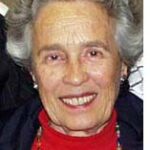By Eileen Wingard

LA JOLLA, California — The creative touch of Summerfest director, Inon Barnatan, was felt throughout the August 7 program in the Conrad’s Baker-Baum Concert Hall, even though he was not performing himself.
There was a free Prelude performance of Haydn’s String Quartet in D Major, Opus 20, No. 4 by the Abeo Quartet, one of two fellowship ensembles at the festival. Their playing was characterized by youthful exuberance and remarkable dynamic contrasts. Twenty minutes later, the Mozart/Pärt Concert began. First, there was an introductory video with photos of the featured composers and Barnatan speaking about their lives and why he connected them.
After the screen was removed, four musicians took their place on stage, violinists Erin Keefe and Stefan Jackiw, violist Nicole Divall and cellist Sterling Elliot. However, they held their instruments in silence. Suddenly, an ethereal sound emerged from above. Three women and five men of VOCES8, from the back wall of the second level, were singing Part’s “Solfeggio.”
This a cappella piece for four voices was one of the Estonian composer’s first works to enter the repertoire. It was captivating in its simplicity and calming dissonance. Without pause, the string quartet on stage began playing the introductory Adagio from the first movement of Wolfgang Amadeus Mozart’s “Dissonance” Quartet. It felt like a natural connection, an obvious relationship between the contemporary Arvo Pärt’s opus, composed in 1963 and Mozart’s “Dissonance” Quartet, completed in 1785.
It is quite remarkable how four outstanding musicians can come together at a festival such as Summerfest and after a few rehearsals, sound like a seasoned ensemble. So it was with this foursome as they projected the joy and beauty of the four-movement work, written when 25-year-old Mozart just moved to Vienna and was inspired by the string quartets of Haydn.
Next was “Spiegel Im Spiegel” by Pärt, performed by violinist Stefan Jackiw and pianist Anna Han. The eight-minute piece consists of the violin playing long sustained notes over the piano’s succession of even quarter notes. It creates a hypnotic effect and it has been used in the sound track of films and for meditation.
This was followed by Mozart’s Duo for Violin and Cello in G Major, originally written for violin and viola, played by violinist Blake Pouliot and cellist Sterling Elliot. They performed the three-movement work with elegance and charm as they shared equally in the musical riches. Although Mozart played both violin and viola, this is one of only two such duets that he composed.
Next was Pärt’s “Fratres” for Cello, String Orchestra and Percussion, with Alisa Weilerstein as soloist. The solo line, beginning with harmonic arpeggios as she rapidly rocked her bow back and forth across the cello strings, soon evolved into a melody, which she projected with luscious sounding presence. This ten-minute work was first conceived for string quartet and wind quintet and later emerged into other iterations. It was influenced by Franco-Flemish Gothic and Renaissance polyphony. The accompanying string orchestra, all standing, except the cello, remained in darkness and only the cello was spotlighted. It was not only musically engaging but dramatically compelling–another creative concept of Barnatan’s.
The final work on the program brought back VOCES8, this time on stage, surrounded by the festival orchestra, to perform the brief “Ave Verum Corpus” by Mozart. For this work, they were all illuminated.
This midweek concert was without intermission, another innovation of the creative music director of Summerfest, Inon Barnatan.
*
Eileen Wingard is a freelance writer specializing in coverage of the arts.
Terrific review, sensitive to the concepts so carefully crafted in this performance/presentation and meticulously described in detail the review. Brings the music to life.